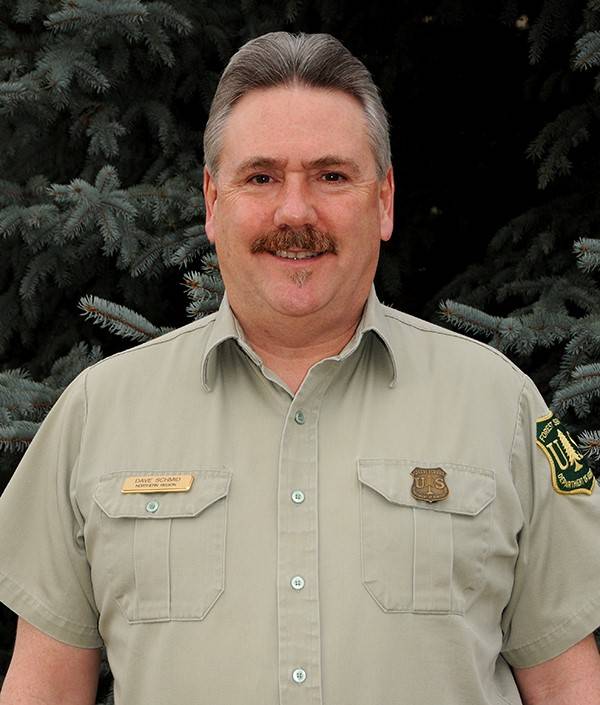A new top official will oversee Alaska’s 22 million acres of National Forest System lands.
David Schmid, a 30-year veteran of the U.S. Forest Service, will take over for retiring Regional Director Beth Pendleton in April, according to a recent USFS announcement. It’s not a permanent position: Schmid been hired to take over for an indefinite period before the USFS can find a permanent regional forester.
Pendleton, 59, will continue to live in Juneau, where her spouse works for the State of Alaska.
“It’s our home,” she said in a Wednesday phone interview.
Pendleton spent eight years as regional forester for the Alaska Region, the top post in the state, and 30 years total with the USFS. She said a few highlights were her to work to strengthen rural communities, the 1990s expansion of the Mendenhall Glacier Visitor Center and transporting a 74-foot Christmas tree from Seward, Alaska, to Washington, D.C.’s Capitol Grounds in 2015.
But above all, she’s proud of her staff.
“Those are just a few of the highlights, but I still go back to working with a great group of employees here,” she said.
In a time of transition for the Tongass National Forest and belt-tightening for the wildfire-beleaguered USFS, Schmid said he hopes to leverage 23 years Alaska experience to hit the ground running.
“I’ve touched about every piece of the agency and our programs in my current position,” Schmid said in a Wednesday phone interview from Missoula, Montana. “Twenty-three years in Alaska have prepared me for a number of the issues.”
Schmid will be the acting regional director of the USFS’ Alaska Region, one of nine regions in the U.S. He’ll oversee about 640 federal employees and two national forests: the 17 million-acres Tongass and the 5 million-acres Chugach.
He said in a Wednesday morning phone interview he’d “certainly be open” to taking a permanent position if it was offered but he’s more focused on doing his best as acting director. It’s not clear yet who the next long-term successor to Pendleton will be.
“My goal and as I’ve done before is not just to keep the chair warm for someone but to actively lead and work with folks in the Alaska Region. I can’t speculate on how long or how permanent that will be,” he said.
Most recently based in Missoula, Montana as a Deputy Regional Forester for the Northern Region, Schmid spent his time in Alaska as a fisheries and watershed program leader on the Chugach National Forest in southcentral and as a district ranger on the Tongass National Forest, according to a USFS staff biography provided to the Empire.
The nation’s largest national forest, the Tongass, may see big changes during Schmid’s tenure, however long it is. U.S. Sen. Lisa Murkowski and Alaska Gov. Bill Walker are both seeking a repeal of the 2001 roadless rule, which blocks the construction of new roads on about 9.5 million acres of Tongass roadless land.
Murkowski is also looking to overturn the USFS Tongass Land and Resource Management Plan, the guiding document for how the USFS manages timber and other natural resources on the Tongass. The plan has the Tongass transitioning over a period of 16 years from logging ecologically important old-growth — the 200-500 years old trees — to so-called young growth trees around 60-100 years old. It also charts a path toward the use of renewable energy to support rural economies.
Murkowski has previously been supportive of the 2016 Tongass plan, created with years of public input, but has recently sought a return to the 2008 Tongass plan through a spending bill currently making its way through Congress.
Schmid said he’d follow whatever direction Congress gives him but for now plans on moving forward with the 2016 Tongass plan, which is still in place. The USFS doesn’t officially weigh in on political discussions like the direction of the Tongass plan or the roadless rule.
“I do know there are certainly some challenges around the current plan. I will be looking forward to learning more and hearing from folks,” Schmid said, adding, “I’ve learned from experience not to jump on things real quickly and I’ve tried to practice a whole lot more active listening before moving.”
Schmid also said he’d also prioritize the health of USFS workplaces as recent news reports and an internal investigation found systemic problems with how the agency handled sexual harassment complaints. Widespread harassment at the USFS was first reported in 2014. Most recently, USFS Chief Tony Tooke resigned earlier this month after PBS Newshour reported that the U.S. Department of Agriculture, which oversees the Forest Service, was investigating sexual misconduct complaints against him.
“It’s critical,” Schmid said, to ensure his employees feel safe at work and that the USFS enforces its zero-tolerance policy on harassment during his tenure. He said he’ll work to ensure the correct processes are in place for addressing complaints.
Tooke was replaced by Interim Chief Vicki Christiansen, who announced Schmid’s hiring via a press release March 16.
Schmid said he has worked closely with Pendleton before and has admired her work during his USFS career. The two will overlap for about a week to bring Schmid up to speed.
“I would tip my hat to Beth. I think she’s done a wonderful job leading the Alaska Region,” Schmid said. “So I am excited for the opportunity to come up and fill in behind her.”
• Contact reporter Kevin Gullufsen at 523-2228 and kgullufsen@juneauempire.com. Follow him on Twitter at @KevinGullufsen.

